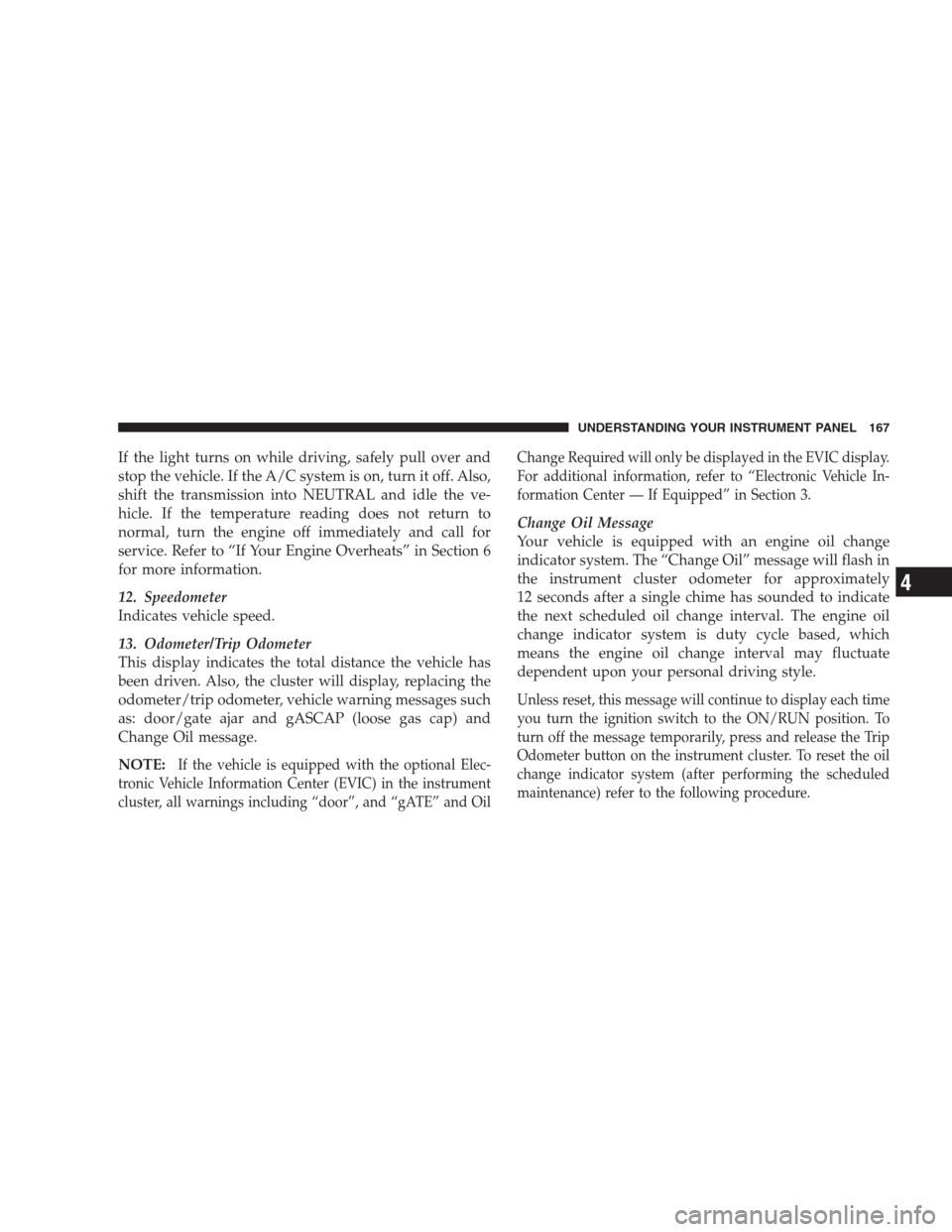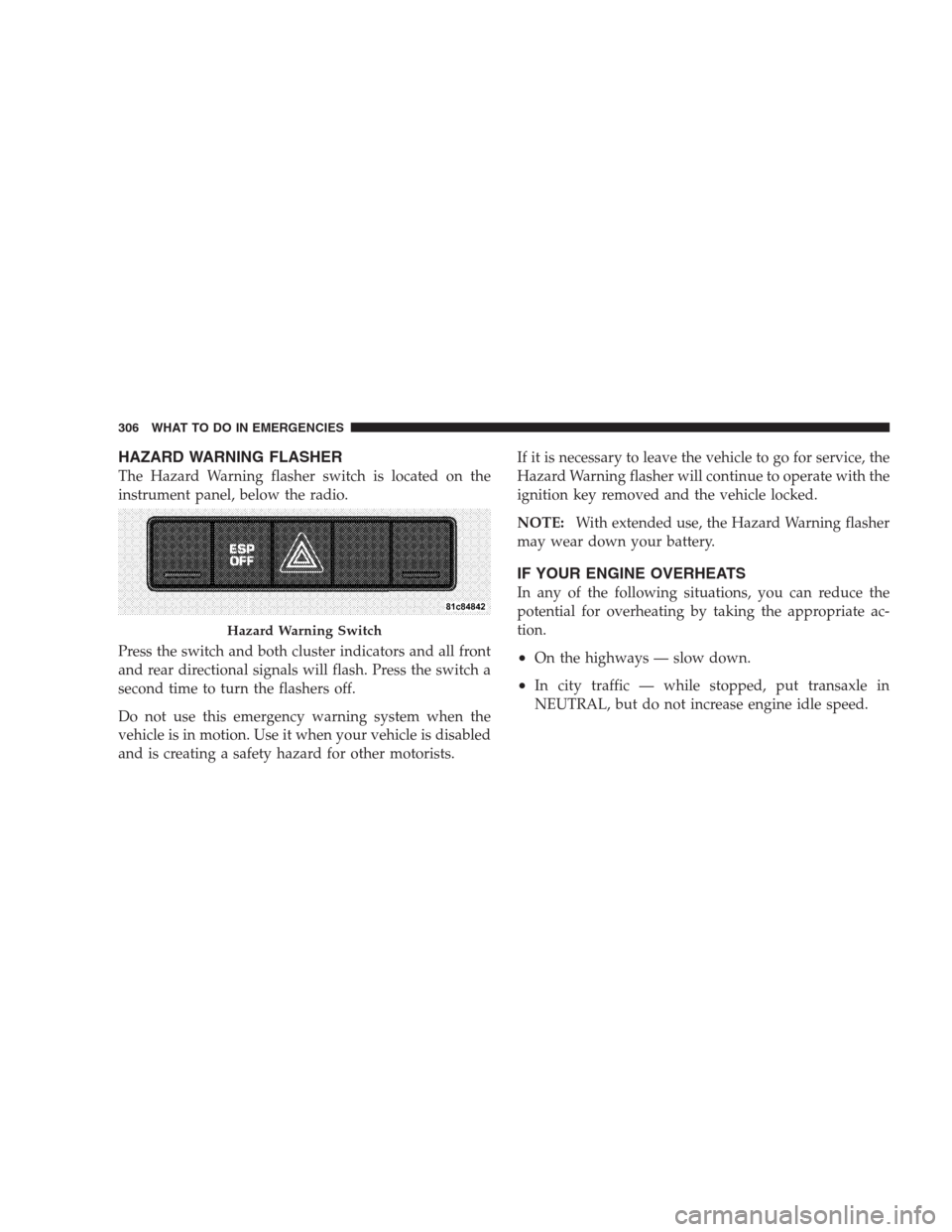Page 166 of 411

INSTRUMENT CLUSTER DESCRIPTIONS
1. Fuel Gauge
When the ignition switch is in the ON position, the
pointer will show the level of fuel remaining in the fuel
tank.
2. Fuel Door Indicator
This indicates that the Fuel Filler Door is
located on the left side of the vehicle.
3. Temperature Gauge
The temperature gauge shows engine coolant tem-
perature. Any reading below thered(260 °F /
126.6 °C) area of the gauge shows that the engine
cooling system is operating properly. The gauge pointer
may show a higher than normal temperature when
driving in hot weather, up mountain grades, or in heavy
stop-and-go traffic.If the pointer rises to theredmark (260 °F / 126.6 °C), the
instrument cluster will sound a chime. Pull over and stop
the vehicle. Idle the vehicle with the air conditioner
turned off until the pointer drops back into the normal
range. If the pointer remains on theredmark (260 °F /
126.6 °C), turn the engine off immediately and call for
service.
There are steps that you can take to slow down an
impending overheat condition. If your air conditioning is
on, turn it off. The air conditioning system adds heat to
the engine cooling system and turning off the A/C
removes this heat. You can also turn the Temperature
control to maximum heat, the Mode control to Floor and
the Fan control to High. This allows the heater core to act
as a supplement to the radiator and aids in removing heat
from the engine cooling system.
164 UNDERSTANDING YOUR INSTRUMENT PANEL
Page 168 of 411

9. Seat Belt Reminder Light
When the ignition switch is first turned ON, this
light will turn on for five to eight seconds as a bulb
check. During the bulb check, if the driver’s seat
belt is unbuckled, a chime will sound. After the bulb
check or when driving, if the driver’s seat belt remains
unbuckled, the Seat Belt Reminder Light will illuminate
and the chime will sound. Refer to “Occupant Restraints”
in Section 2 for more information.
10. Oil Pressure Warning Light
This light indicates low engine oil pressure. The
light should turn on momentarily when the engine
is started. If the light turns on while driving, stop the
vehicle and shut off the engine as soon as possible. A
chime will sound for four minutes when this light turns
on.Do not operate the vehicle until the cause is corrected.
This light does not show how much oil is in the engine.
The engine oil level must be checked under the hood.
11. Engine Temperature Warning Light
This light warns of an overheated engine condi-
tion. As temperatures rise and the gauge ap-
proaches red (260°F/126.6°C), this indicator will
illuminate and a single chime will sound after reaching a
set threshold. Further overheating will cause the tem-
perature gauge to pass red (260°F/126.6°C), the indicator
will continuously flash and a continuous chime will
occur until the engine is allowed to cool.
166 UNDERSTANDING YOUR INSTRUMENT PANEL
Page 169 of 411

If the light turns on while driving, safely pull over and
stop the vehicle. If the A/C system is on, turn it off. Also,
shift the transmission into NEUTRAL and idle the ve-
hicle. If the temperature reading does not return to
normal, turn the engine off immediately and call for
service. Refer to “If Your Engine Overheats” in Section 6
for more information.
12. Speedometer
Indicates vehicle speed.
13. Odometer/Trip Odometer
This display indicates the total distance the vehicle has
been driven. Also, the cluster will display, replacing the
odometer/trip odometer, vehicle warning messages such
as: door/gate ajar and gASCAP (loose gas cap) and
Change Oil message.
NOTE:
If the vehicle is equipped with the optional Elec-
tronic Vehicle Information Center (EVIC) in the instrument
cluster, all warnings including “door”, and “gATE” and OilChange Required will only be displayed in the EVIC display.
For additional information, refer to “Electronic Vehicle In-
formation Center — If Equipped” in Section 3.
Change Oil Message
Your vehicle is equipped with an engine oil change
indicator system. The “Change Oil” message will flash in
the instrument cluster odometer for approximately
12 seconds after a single chime has sounded to indicate
the next scheduled oil change interval. The engine oil
change indicator system is duty cycle based, which
means the engine oil change interval may fluctuate
dependent upon your personal driving style.
Unless reset, this message will continue to display each time
you turn the ignition switch to the ON/RUN position. To
turn off the message temporarily, press and release the Trip
Odometer button on the instrument cluster. To reset the oil
change indicator system (after performing the scheduled
maintenance) refer to the following procedure.
UNDERSTANDING YOUR INSTRUMENT PANEL 167
4
Page 301 of 411

content of gasoline may not be indicated on the pump,
you should ask your gasoline retailer if the gasoline
contains MMT.
It is even more important to look for gasolines without
MMT in Canada, because MMT can be used at levels
higher than allowed in the United States. MMT is pro-
hibited in Federal and California reformulated gasolines.
Materials Added To Fuel
All gasoline sold in the United States is required to
contain effective detergent additives. Use of additional
detergents or other additives are not needed under
normal conditions and they would result in additional
cost. Therefore, you should not have to add anything to
the fuel.
Fuel System Cautions
CAUTION!
Use the following guidelines to maintain your vehi-
cle’s performance:
•The use of leaded gas is prohibited by Federal law.
Using leaded gasoline can impair engine performance,
or damage the emissions control system.
•An out-of-tune engine, or certain fuel or ignition
malfunctions, can cause the catalytic converter to
overheat. If you notice a pungent burning odor or
some light smoke, your engine may be out-of-tune or
malfunctioning and may require immediate service.
Contact your authorized dealer for service assistance.
STARTING AND OPERATING 299
5
Page 307 of 411
WHAT TO DO IN EMERGENCIES
CONTENTS
�Hazard Warning Flasher................. 306
�If Your Engine Overheats................ 306
�TIREFIT Kit.......................... 308
▫TIREFIT Storage..................... 308
▫TIREFIT Usage Precautions.............. 308
▫TIREFIT Kit Components & Operation...... 311▫Sealing a Tire With TIREFIT............. 312
�Jump-Starting Procedures................ 317
�Freeing A Stuck Vehicle................. 319
�Towing A Disabled Vehicle............... 320
▫With Ignition Key.................... 320
▫Without The Ignition Key............... 322
6
Page 308 of 411

HAZARD WARNING FLASHER
The Hazard Warning flasher switch is located on the
instrument panel, below the radio.
Press the switch and both cluster indicators and all front
and rear directional signals will flash. Press the switch a
second time to turn the flashers off.
Do not use this emergency warning system when the
vehicle is in motion. Use it when your vehicle is disabled
and is creating a safety hazard for other motorists.If it is necessary to leave the vehicle to go for service, the
Hazard Warning flasher will continue to operate with the
ignition key removed and the vehicle locked.
NOTE:With extended use, the Hazard Warning flasher
may wear down your battery.
IF YOUR ENGINE OVERHEATS
In any of the following situations, you can reduce the
potential for overheating by taking the appropriate ac-
tion.
•On the highways — slow down.
•In city traffic — while stopped, put transaxle in
NEUTRAL, but do not increase engine idle speed.
Hazard Warning Switch
306 WHAT TO DO IN EMERGENCIES
Page 309 of 411

If the pointer rises to theredmark (260 °F / 126.6 °C), the
instrument cluster will sound a chime. Pull over and stop
the vehicle with the engine at idle, when safe. Turn off the
air conditioning and wait until the pointer drops back
into the normal range. If the pointer remains on thered
mark (260 °F / 126.6 °C) for more than a minute, turn the
engine off immediately and call for service.
NOTE:There are steps that you can take to slow down
an impending overheat condition. If your air conditioner
is on, turn it off. The air conditioning system adds heat to
the engine cooling system and turning off the A/C
removes this heat. You can also turn the Temperature
control to maximum heat, the Mode control to floor, and
the Fan control to High. This allows the heater core to act
as a supplement to the radiator and aids in removing heat
from the engine cooling system.CAUTION!
Driving with a hot cooling system could damage
your vehicle. If the temperature gauge reads 260 °F
(126.6 °C), pull over and stop the vehicle with the
engine at idle, when safe. Turn the air conditioner off
and wait until the pointer drops back into the normal
range. After appropriate action has been taken, if the
pointer remains on the red mark (260 °F / 126.6 °C),
turn the engine off immediately, and call for service.
WHAT TO DO IN EMERGENCIES 307
6
Page 310 of 411
WARNING!
A hot engine cooling system is dangerous. You or
others could be badly burned by steam or boiling
coolant. You may want to call a service center if your
vehicle overheats. If you decide to look under the
hood yourself, refer to Section 7, Maintenance, of this
manual. Follow the warnings under the Cooling
System Pressure Cap paragraph.
TIREFIT KIT
Small punctures in the tire tread can be sealed with
TIREFIT. Foreign objects (e.g., screws or nails) should not
be removed from the tire. TIREFIT can be used in outside
temperatures down to approximately -4°F (-20°C).
TIREFIT Storage
The TIREFIT kit is located in the trunk.
TIREFIT Usage Precautions
NOTE:
•Replace the TIREFIT Sealant Bottle prior to the expi-
ration date (printed on the bottle label) to assure
optimum operation of the system.
TIREFIT Location
308 WHAT TO DO IN EMERGENCIES